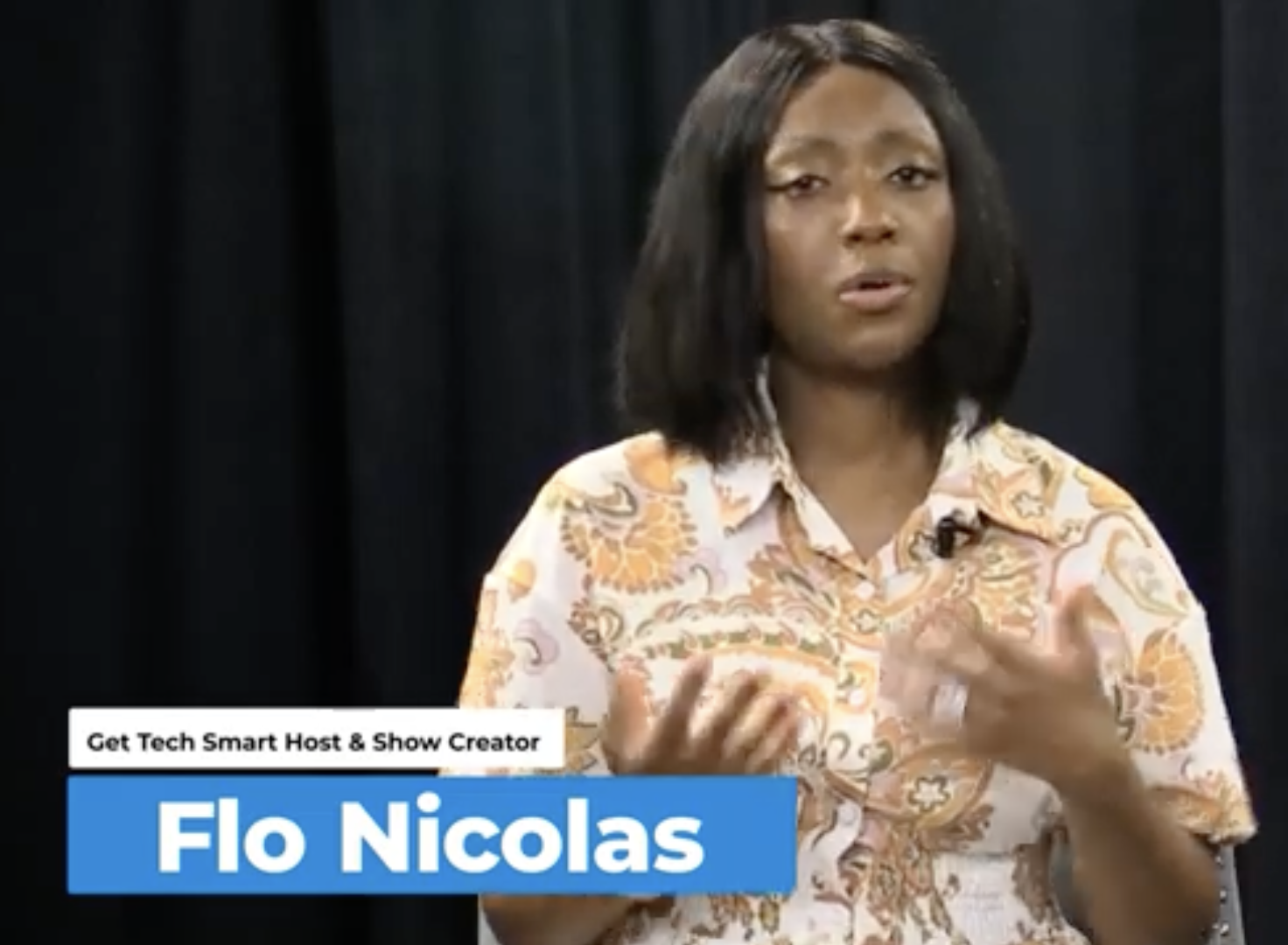Get Tech Smart: Boosting Your Website Traffic
In this episode of Get Tech Smart, Flo Nicolas is joined by Logan Ares Snyder, the Owner & Lead Strategist of hasOptimization, to dive deep into the art of driving website traffic. They discuss website analytics, shedding light on essential tools such as Google Analytics and Facebook Analytics, and

Flo Nicolas is a technologist, lawyer, speaker, mentor, writer, tech startup Founder/CEO of CheapCheep & Director, and Creator of Get Tech Smart. She is a dedicated professional with a passion for technology and creative innovation, intent on helping her community to become more tech-savvy and forward-thinking.
In this episode of Get Tech Smart, Flo Nicolas is joined by Logan Ares Snyder, the Owner & Lead Strategist of hasOptimization, to dive deep into the art of driving website traffic. They discuss website analytics, shedding light on essential tools such as Google Analytics and Facebook Analytics, and highlighting the key differences between these analytics platforms.
This article has been edited for length and clarity.

Flo Nicolas:
So, welcome, again. Really glad to have you here. And you can call yourself like a little Google Analytics expert guru.
Logan Ares Snyder:
I think my LinkedIn says something like a digital marketing wizard is my title. Actually.
Flo Nicolas:
Let’s start with that aspect of playing with data and what it means for businesses no matter their size, why should businesses be leveraging data analytics right now? 2023? Why is it crucial?
Logan Ares Snyder:
I mean, this is the best time to do it was 10 years ago. And the second best time, as with everything, is now, there’s a saying in analytics, that if you can’t measure something, you can’t improve it. And it might be more accurate to say, you might improve it, but you won’t know that you are, and you certainly won’t be doing so in a strategic way. Right. So in order to be able to make improvements in your website, and your marketing and your business, you need to know what you’re working with, you need to know what your starting point is. And you need to be able to see what’s changing as you make decisions, as you undergo marketing efforts, as you do anything with that business. And with your websites and with your web presence, or with your other marketing for that matter. There’s also offline marketing that can become digital analytics data. There’s all kinds of fun stuff in here. And I could go on at great length. But in essence, it’s important because you need to know what is happening, what your starting point is, and what is changing as you do experiments, in essence, in order to really make meaningful progress.
Flo Nicolas:
Where do I even start? And how do I even leverage Google Analytics? So let’s dive in for us into the glare.
Logan Ares Snyder:
Yeah, learning to interpret the data that you’re looking at in a system like that is a learning process. That’s something that you are not going to be good at instantaneously. I wasn’t good at it instantaneously. And now that’s my profession, in essence. I’ve been doing this for about 13 years now. I’ve been working with Google Analytics and related systems.
So the first thing that any business owner can do is just install that tracking code on their website. Basically, any website platform you can install Google Analytics on, you can install it directly. Or you can do it using a system called Tag Manager, which is kind of like a little storage system for tags, adds a little bit of complexity in some ways, but makes some other things easier later. Google will tell you how to get this code installed on your website, as long as you know how to find those correct places to install it. And it’s a little bit different for each different site’s system. For example, if you’re on WordPress, you might install it using a plugin, or you might install it using a Tag Manager plugin. If you’re on something like Squarespace or Wix, those have just fields that say, put your code here. And that works. There’s other ways to do it, too. But that’s the quick and easy way if you’re trying to just get yourself started.
Flo Nicolas:
But then now people are trying to figure out there’s so many analytics software out there, right, so we just talked about Google. But then there’s also Facebook, and what’s the difference, and what’s gonna be more robust. And, just let’s talk about that.
Logan Ares Snyder:
There are a variety of tools out there that either sort of run analytics for specific purposes, like the Facebook pixel, or which are sort of Google Analytics competitors. And just like many people use, say, QuickBooks, there’s also other software that is very similar to QuickBooks that you could have, instead, it does all of the same things more or less. But it’s not exactly the same. Something like the Facebook pixel is there, mostly to help you with analysis of something like your Facebook ads, and it’s specifically there to send that data back to Facebook, so that Facebook knows which advertising you’re running that is causing people to take actions on your website that you want. Without that Facebook only knows what happens on Facebook’s website, in the same way that your Google Analytics tracking code you install on your own website can only tell you about your own website, Facebook can only know what happens on Facebook, unless you’ve got that Facebook pixel. Because the Facebook pixel is effectively going okay, Facebook, you can have some of my data from my website. I want to know what people do on my website when they come here from Facebook, so that you can help me optimize my advertising, to get people to do more of the actions that I want. And it’s pretty effective advertising that has that Facebook pixel, Conversion Tracking Enabled, works better than advertising, that’s just going okay, I want as many people as possible to click on this link and come to my website. I mean, that’s cool. And all traffic is good.
But traffic is less important than that conversion action. I can send 1000 people to your website, but if they’re not the right people, and for example, if they’re doing what’s called bouncing, they’re hitting your website going, Oh, this is what I wanted, and leaving immediately. That’s not actually of any value to you. And if you’re talking about advertising, you’re spending money to get those people to your website. But if they’re not the right people that’s wasted money, in the same way it is like if I send 500 people into your storefront, but they’re not people who are in the market for what you’re selling. I’ve just wasted your time, basically. Yeah. So from what I get from that is that when you’re using Facebook, it’s more focused on the ad that you are creating within Facebook. So the analytics that you’re getting are more Facebook specific. Yeah, the Facebook pixel is there to help you run better Facebook advertising and to a certain extent the organic work as well, but primarily, you install that Facebook pixel because you want to improve your Facebook ads. That is mostly useful information in that Facebook ads context, it’s not going to really help you with things like search engine optimization, right? Because that’s not what it’s there for. It’s there for meta stuff, Facebook stuff, Instagram stuff, right?
Flo Nicolas:
So in closing, what are some last words, or tips that you want to provide to the audience, when it comes to Google Analytics and SEO?
Logan Ares Snyder:
I would say start measuring your traffic. The best time to start was the minute you launch that website. And the second best time is now. In fact, we just launched a new version of Google Analytics. And when I say we, I don’t mean me personally, Google did this. So if you’ve never had Google Analytics before, now is a great time to get the brand new version on your website. Basically everyone’s starting over a little bit because it’s all new. So jump in the pond now.
Flo Nicolas:
Yeah, jump in start out during those conversion rates. So Logan it’s been fantastic having you here. This has been like I’ve learned a lot. And I’m, I’m definitely going to be doing Google Trends for my business. So I appreciate that. And listen, if there’s any changes or any new tips that you want to come back and talk about you are more than welcome to come back. And for everybody else watching at home. I hope you took notes because there was a lot of golden nuggets here today. And thank you for watching another episode of Get Tech Amart. Stay tuned for more.

Get Tech Smart is being shared with members of The Granite State News Collaborative.





